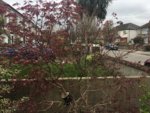Hi,
I have done an air layer this spring on a maple. I’ve noticed that the are of the tree above the layer has significantly more leaf out than the other areas . I hope it is noticeable in the photo attached.
Theory 1
There is more moisture coming from the air layer area which is supplying water to the branch. I don’t know how feasible this is as I thought moisture comes up from the roots and there would not be roots in he layer yet .
Theory 2
The tree has identified an injury and has pushed leaves in that area in order to get the sugars moving down to heal the wound .
I would be interested to hear your opinions on why this is occurring.
It is not a problem as such but I find it interesting.
Regards
Spunog
I have done an air layer this spring on a maple. I’ve noticed that the are of the tree above the layer has significantly more leaf out than the other areas . I hope it is noticeable in the photo attached.
Theory 1
There is more moisture coming from the air layer area which is supplying water to the branch. I don’t know how feasible this is as I thought moisture comes up from the roots and there would not be roots in he layer yet .
Theory 2
The tree has identified an injury and has pushed leaves in that area in order to get the sugars moving down to heal the wound .
I would be interested to hear your opinions on why this is occurring.
It is not a problem as such but I find it interesting.
Regards
Spunog

